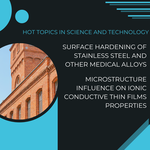Hot Topics in Science and Technology

The Institute of Physics invites you to seminars in the “Hot Topics in Science and Technology” series:
Surface hardening of stainless steel and other medical alloys
Teresa Moskaliovienė
Faculty of Mathematics and Natural Sciences, Kaunas University of Technology, Lithuania
Microstructure influence on ionic conductive thin films properties
Kristina Bočkutė
Faculty of Mathematics and Natural Sciences, Kaunas University of Technology, Lithuania
The seminars will be held on April 25, 2024 at 12:15 pm in the Arena Magica auditorium of the Institute of Physics (building B14).
Surface hardening of stainless steel and other medical alloys
The demand for improvement of lifetime and biocompatibility of medical implants is ever growing. The materials used in this challenging application must display enhanced mechanical and tribological properties, biocompatibility and reduced metal ion release in long-term clinical performance. Surface modification techniques such as low-temperature nitriding have become a valuable method for improving the surface hardness of the medical grade alloys (stainless steels, Co–Cr alloys) and thus their tribological properties, without impairing their corrosion resistance. The origin of these improvements is that the nitrogen diffusion process results in the formation of nitrogen-rich expanded austenite layer, which essentially is a supersaturated solid solution of interstitial nitrogen atoms in austenite and without chromium nitride precipitation. This lecture provides a brief overview of surface hardening processes in stainless steel and other medical alloys. The main studies on the formation of expanded austenite phase and nitrogen transport mechanisms will be discussed.
Microstructure influence on ionic conductive thin films properties
The lecture will provide an overview of thin film formation processes and their influence on the microstructure of the formed thin films. Through an analysis of vapour deposition techniques, attendees gain insights into how manipulating microstructure can enhance the conductivity, stability, and functionality of these thin films, thereby encouraging advancements in diverse applications.


